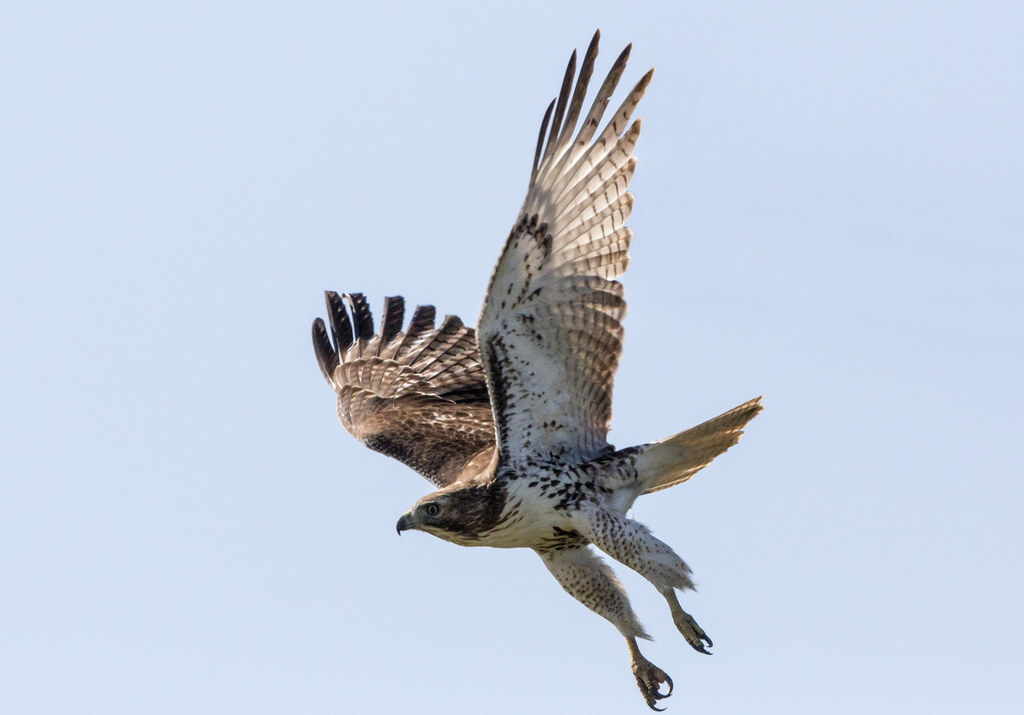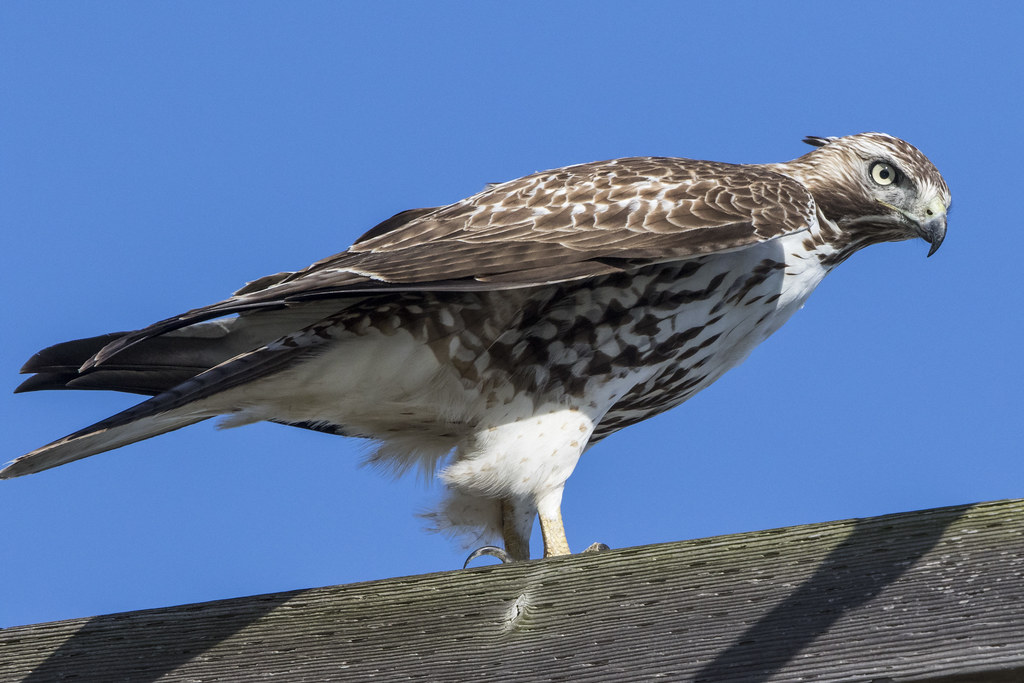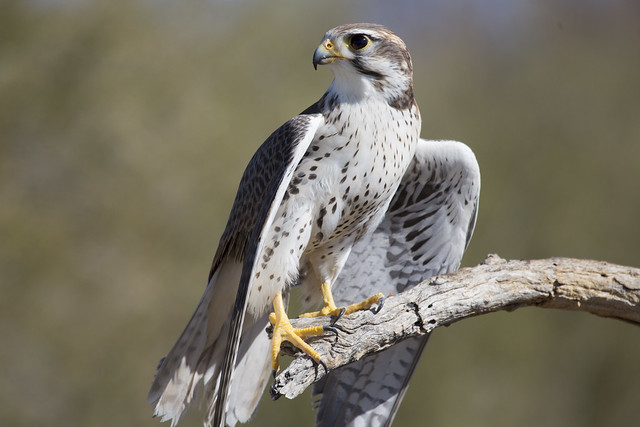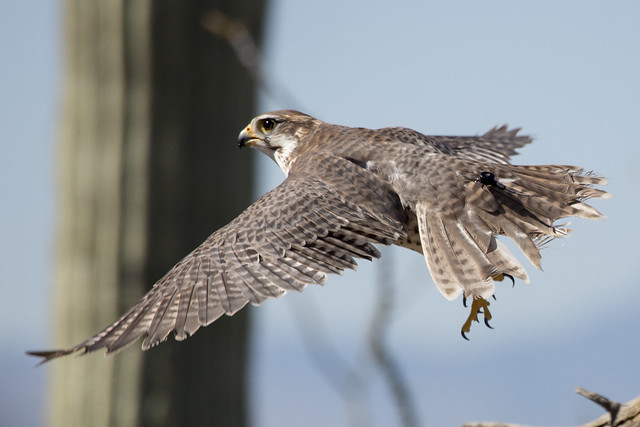Skip to comments.
Need Help identifying this Hawk/Raptor ~ Vanity
Posted on 06/21/2015 6:09:41 PM PDT by GraceG
So across my street there is Hawk or big Raptor type bird that lives in a tree, well this spring it had some hatch-lings and now they are flying around the nearby house shrieking and raising a ruckus, think the momma bird tossed them out of the nest as they can now fly. Wondering if any freeples out there have any idea what sort bird this is, I managed to get some up close pics of them. I need a few questions answered.
1. Will they damage my property?
2. Will they kill the squirrels that actually do damage my property?
3. If #1 is no, and #2 is yes, is there anyway to entice them to stay?
Picture Below:
TOPICS: Outdoors; Pets/Animals
KEYWORDS: bird; hawk; raptop
Navigation: use the links below to view more comments.
first previous 1-20 ... 61-80, 81-100, 101-120, 121-123 next last
To: GraceG
Peterson Field Guide description of a Immature Broad Winged Hawk. “Heavily streaked along sides of neck, breast, and belly: chest often unmarked. Tail has several narrow dark bands: terminal dark band twice as wide as the rest. Rare dark morph, which breeds in Prairie Province, has dark wing lining but shows usual Broad-winged tail pattern.”
You did not indicate where you live in the country which is used to identify birds. I do not believe it is a red tailed hawk. I have seen many and bird watch as a hobby.
Voice: High-pitched, shrill, two-part downward pwe-eeeeee. Nest in trees usually 24-40 feet up. Small poorly built out of sticks, dead leaves. Usually a re-build squirrel, hawk or crow nest.
Range N. Dakota (Turtle Mts.) Nebraska (Missouri R.) Kansas (rare) Oklahoma and east Texas Minnesota and south to Louisiana. Thorough East US rarely in Florida.
www.allaboutbirds.org/guide/Broad-winged_Hawk/id
81
posted on
06/21/2015 8:37:06 PM PDT
by
GSAonce
To: GraceG
Peterson Field Guide description of a Immature Broad Winged Hawk. “Heavily streaked along sides of neck, breast, and belly: chest often unmarked. Tail has several narrow dark bands: terminal dark band twice as wide as the rest. Rare dark morph, which breeds in Prairie Province, has dark wing lining but shows usual Broad-winged tail pattern.”
You did not indicate where you live in the country which is used to identify birds. I do not believe it is a red tailed hawk. I have seen many and bird watch as a hobby.
Voice: High-pitched, shrill, two-part downward pwe-eeeeee. Nest in trees usually 24-40 feet up. Small poorly built out of sticks, dead leaves. Usually a re-build squirrel, hawk or crow nest.
Range N. Dakota (Turtle Mts.) Nebraska (Missouri R.) Kansas (rare) Oklahoma and east Texas Minnesota and south to Louisiana. Thorough East US rarely in Florida.
www.allaboutbirds.org/guide/Broad-winged_Hawk/id
82
posted on
06/21/2015 8:37:21 PM PDT
by
GSAonce
To: GSAonce
Denver Colorado area, east side of denver (plains side)
83
posted on
06/21/2015 8:38:24 PM PDT
by
GraceG
(Protect the Border from Illegal Aliens, Don't Protect Illegal Alien Boarders...)
To: GraceG
Peterson Field Guide description of a Immature Broad Winged Hawk. “Heavily streaked along sides of neck, breast, and belly: chest often unmarked. Tail has several narrow dark bands: terminal dark band twice as wide as the rest. Rare dark morph, which breeds in Prairie Province, has dark wing lining but shows usual Broad-winged tail pattern.”
You did not indicate where you live in the country which is used to identify birds. I do not believe it is a red tailed hawk. I have seen many and bird watch as a hobby.
Voice: High-pitched, shrill, two-part downward pwe-eeeeee. Nest in trees usually 24-40 feet up. Small poorly built out of sticks, dead leaves. Usually a re-build squirrel, hawk or crow nest.
Range N. Dakota (Turtle Mts.) Nebraska (Missouri R.) Kansas (rare) Oklahoma and east Texas Minnesota and south to Louisiana. Thorough East US rarely in Florida.
84
posted on
06/21/2015 8:38:39 PM PDT
by
GSAonce
To: GraceG
Peterson Field Guide description of a Immature Broad Winged Hawk. “Heavily streaked along sides of neck, breast, and belly: chest often unmarked. Tail has several narrow dark bands: terminal dark band twice as wide as the rest. Rare dark morph, which breeds in Prairie Province, has dark wing lining but shows usual Broad-winged tail pattern.”
You did not indicate where you live in the country which is used to identify birds. I do not believe it is a red tailed hawk. I have seen many and bird watch as a hobby.
Voice: High-pitched, shrill, two-part downward pwe-eeeeee. Nest in trees usually 24-40 feet up. Small poorly built out of sticks, dead leaves. Usually a re-build squirrel, hawk or crow nest.
Range N. Dakota (Turtle Mts.) Nebraska (Missouri R.) Kansas (rare) Oklahoma and east Texas Minnesota and south to Louisiana. Thorough East US rarely in Florida.
85
posted on
06/21/2015 8:41:35 PM PDT
by
GSAonce
To: yarddog
That was my thought — a little undignified.
To: rlmorel
It does look very much like a red tail, we have them all over our property. The locals call them chicken hawks, and for good reason...they will decimate free range chickens.
87
posted on
06/21/2015 9:29:11 PM PDT
by
JGT
To: MS.BEHAVIN
I agree that the bird looks a lot like a Falcon.
88
posted on
06/21/2015 9:46:13 PM PDT
by
Doc91678
(Doc91678)
To: GraceG
It looks to be either a red tail or a Cooper’s hawk.
89
posted on
06/21/2015 9:59:27 PM PDT
by
puppypusher
( The World is going to the dogs.)
To: GraceG
90
posted on
06/21/2015 10:00:18 PM PDT
by
glasseye
To: nuconvert; GraceG
I was inclined to say Northern Goshawk as well, based mostly on the flecking on the legs, but adolescent birds of prey are very different from adult birds. Also, Northern Goshawks would probably not nest near humans. They are a bit reclusive, deep woods birds.
The definitive answer would be had in taking a look at the eyes of the parents. I recall that adult Northern Goshawks have red eyes, which is something you don't see very often.
91
posted on
06/21/2015 10:43:40 PM PDT
by
Rodamala
To: djf
I have a pair of nesting Bald Eagles near me. Last winter I spotted them flying over... as I stood in my driveway talking to the neighbor, who had told me 2 minutes earlier that there are bald eagles nesting behind his house.
The next week I went outside and saw one of them again, swooping around the front of the house, when I noticed 2 girls out standing on the bridge over the creek. I turns out they saw it on the frozen creek and turned their car around to look and the bird tried to carry off a dead beaver carcass but it was too heavy and dropped it back down on the frozen over creek.
92
posted on
06/21/2015 10:53:33 PM PDT
by
Rodamala
To: GraceG
Red-tailed hawks show quite a bit of variability in how they look. Here are a couple that seem fairly typical:
 This photo from Kingsville, Texas showsshows:
This photo from Kingsville, Texas showsshows:
- dark patagial markings under the leading edge of the wing (a red-tailed hawk marker)
- dark banding on the leg feathers like your bird
- the top of the tail has narrow dark banding like your bird
- the underside of the tail is basically white like your bird
- white chest and dark markings on the belly like your bird
Here is a photo of a different juvenile red-tailed also from the Kingsville area:

The tail is white underneath and the top has the narrow dark bands of a juvenile red-tailed.
To: GraceG
Certainly looks like a prairie falcon. Peregrines have a much darker facial mask.
94
posted on
06/21/2015 11:00:34 PM PDT
by
EinNYC
To: nuconvert
I’ll go for “Goshawk” for $2,000, Alex. Look at the plumage on the legs. Red hawks don’t have that.
Once saw a Red hawk at the bus stop at the Pentagon (where else would you find a hawk?). Had a wingspan of at least 5 feet, and sat unnoticed on a chain-link fence at the new bus-stops.
I had spotted him in a tree about 200-300 feet away (he stood out among all the other birds), but when he flew in and landed on the fence, you knew who he was, the king of the sky.
Awesome bird. He looked around, decided not to eat any of those waiting in line, and took off in one major flap of his wings.
Today Obama has outlawed any hawks in or near the Pentagon.
To: philetus
The Hawk:
96
posted on
06/21/2015 11:09:38 PM PDT
by
Rodamala
To: EinNYC
I don't think it is a prairie falcon. At least, it doesn't match my photos of one.

- The markings on the chest don't match the photos in question.

- The tail does have similar markings to the bird in question but the back doesn't have the many white spots that red-tailed have.
Although not shown in these photos the prairie falcon leg feathers do have dark spots on them.
To: GraceG
Sounds like this bird (if it is a Swainson’s) will not stick around. Check and see if barn owls live in your area. If so, you might build a barn owl box (find instructions online, we did!) and install it in your back yard or wherever. We used to have an awful problem with gophers. The barn owl box that we built stayed empty for five years, but in year six, they moved in, raised chicks, and cleaned out the gophers in a summer! LOL! It was amazing. The owls moved on but we subsequently ended up with a feral cat (neutered & shots, but she was wild at first) who has kept the population down since then. Barn owls are awesome! (They are a little noisy at night, lots of hissing and squawks, but settle down about an hour after dark.)
BTW, if you do build a barn owl box, check the recommended dimensions of the door and stick with those dimensions. Great horned owls EAT barn owls. The door is sized small, to let barn owls in, but keep the great horned owls out, away from the chicks.
98
posted on
06/22/2015 12:10:13 AM PDT
by
Hetty_Fauxvert
(FUBO, and the useful idiots you rode in on!)
To: GSAonce
This bird’s tail terminates in white, not a dark band.
99
posted on
06/22/2015 1:03:22 AM PDT
by
piasa
(Attitude adjustments offered here free of charge)
To: MomwithHope
Judging by the size of it compared to it’s perch, the pipe the fence is made from, it is not “too small” for a redtail.
100
posted on
06/22/2015 1:04:47 AM PDT
by
piasa
(Attitude adjustments offered here free of charge)
Navigation: use the links below to view more comments.
first previous 1-20 ... 61-80, 81-100, 101-120, 121-123 next last
Disclaimer:
Opinions posted on Free Republic are those of the individual
posters and do not necessarily represent the opinion of Free Republic or its
management. All materials posted herein are protected by copyright law and the
exemption for fair use of copyrighted works.
FreeRepublic.com is powered by software copyright 2000-2008 John Robinson
 This photo from Kingsville, Texas showsshows:
This photo from Kingsville, Texas showsshows: 


